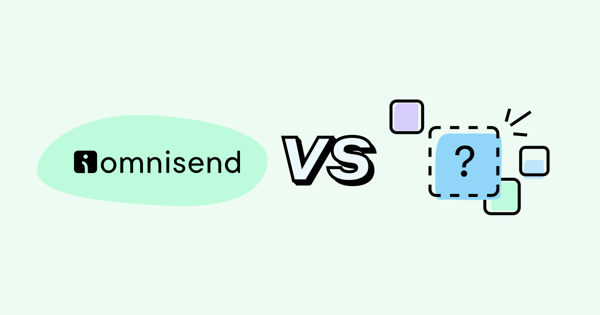With 87 percent of B2C marketers using automation as part of their email marketing strategies, there’s no lack of demand for ecommerce-focused automation platforms.
Omnisend is just such a platform, giving ecommerce brands the power to reach, convert, and retain customers through email and SMS marketing.
But Omnisend is far from the only ecommerce marketing automation tool. Not only are there plenty of direct competitors out there, but pretty much every email marketing platform offers at least some ecommerce functionality.
So which is right for you?
To help you make the right choice, we’ve collated 10 of the best Omnisend alternatives and compared them across the following criteria:
- Price
- Product features
- Customer support
- Pros and cons
- Target audience
Let’s get into it…
What Are the Best Omnisend Alternatives?
| Omnisend Alternatives | Best For | Top Features | Pricing/Month |
| Drip | DTC ecommerce | Segment your whole audience based on real-time store, visitor, and marketing data. | From $39 per month for up to 2,500 contacts and unlimited email sends. |
| Klaviyo | Ecommerce agencies and developers | Personalization and segmentation tools allow you to create customer segments based on real-time data. | Free for up to 250 contacts and 500 monthly email sends; paid plans priced from $20 per month for up to 500 contacts and 5,000 monthly email sends. |
| Mailchimp | Small businesses | Advanced analytics and reporting help marketers make data-driven decisions. | Free for up to 500 contacts and 1,000 monthly email sends; paid plans start at $13 per month for 500 contacts and 5,000 monthly email sends. |
| GetResponse | Small businesses that need advanced marketing tools | Built-in GPT-3.5 powered email generator. | Free for up to 500 contacts and 2,500 monthly email sends. Paid plans start at $13.30 per month for 1,000 contacts and unlimited email sends. |
| Brevo (FKA Sendinblue) | Low-budget email marketing | Send transactional emails with guaranteed 97 percent deliverability. | Free for unlimited contacts and up to 300 emails per day. Paid plans start at $25 per month for unlimited contacts and 20,000 emails per month. |
| ConvertKit | Content creators | Integrated newsletter referral program helps creators grow their reach by leveraging their existing audience. | Free for up to 1,000 subscribers and unlimited email sends; paid plans start at $9 per month for up to 300 subscribers and unlimited sends. |
| ActiveCampaign | Advanced marketers who need high-level automation | Predictive actions use machine learning to deliver customer experiences based on data, such as the best time to send emails. | From $29 per month for one user and unlimited emails. |
| AWeber | Startups and small businesses | Create email templates in seconds using your website or Facebook page URL. | Free for up to 500 email subscribers and 3,000 monthly email sends; paid plans priced from $16.15 per month for up to 2,500 subscribers. |
| Constant Contact | Nonprofits and charities | Manage campaigns on the go from a dedicated mobile app. | From $12 per month for up to 500 contacts and 5,000 monthly email sends. |
| HubSpot | B2B inbound marketing | Connect marketing, sales, content management, and customer service in a single platform. | Free marketing plan includes unlimited contacts and 2,000 monthly email sends. Paid marketing plans start at $18 per month for 1,000 contacts and 5,000 monthly sends. |

The 10 Best Omnisend Alternatives
1. Drip
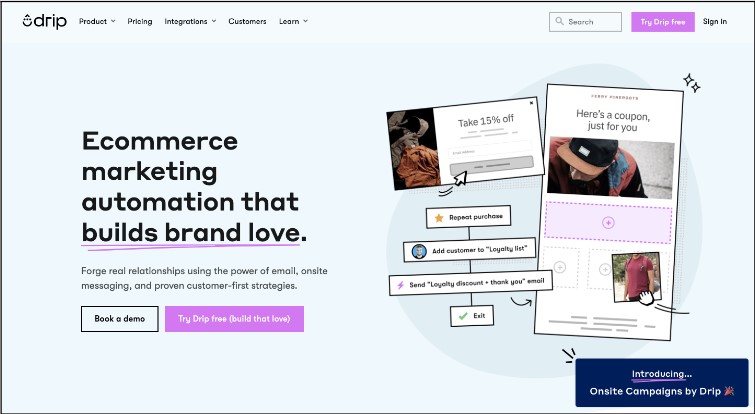 Forgive us for starting with the tool we know best of all: our own.
Forgive us for starting with the tool we know best of all: our own.
We’re Drip, and we’re a marketing platform built for ecommerce brands, particularly DTCs. With our user-friendly point-and-click editor, professionally designed ecommerce templates, and library of pre-made workflows, we make it quick and easy for brands like yours to build high-converting email and onsite campaigns.
What Makes Drip the Best Omnisend Alternative?
- Sophisticated ecommerce functionality for all. Omnisend and Drip are both ecommerce-specific platforms that deliver all the key functionality you need to drive sales online. But Omnisend’s features are pretty limited below the top-tier Pro package, whereas all Drip’s functionality is available to every customer—however much you pay.
- More affordable for advanced marketers. Need unlimited email sends and advanced reporting? With Omnisend, you’ll have to pay $59+ per month for its Pro package. At Drip, you get all that stuff with our entry-level plan, priced from $39 per month.
- Pro-grade customer support. Omnisend provides 24/7 support, but our team goes above and beyond that. We deliver real expertise for ecommerce brands, are quick to respond, and we’ll jump on a live video call to talk through an issue or challenge. We’ll even offer recommendations customized to your brand (whereas Omnisend charges $400+ to speak to a customer success manager).
- User-friendly interface. Customers tell us they love our UI—and that our colorful editor makes building emails, popups, and workflows feel fun. There’s nothing ostensibly wrong with Omnisend’s interface, but it feels less intuitive.
Omnisend vs. Drip: How Do They Stack Up?
| Drip | Omnisend | |
| Best Feature | Segment your whole audience based on real-time store, visitor, and marketing data. | Web push notifications allow brands to instantly retarget customers. |
| Best For | DTC ecommerce | Ecommerce marketers |
| Pros | All customers get access to advanced automations and segmentation, no matter how much you pay. | (Slightly) cheaper if you don’t need advanced reporting or personalized customer support; offers a solid free plan. |
| Cons | No free plan (although we do have a 14-day free trial). | Costs ramp up quickly if you do need advanced features. |
| Pricing/Month | From $39 per month for up to 2,500 contacts and unlimited email sends. | Free to reach up to 250 contacts per month, including 500 monthly email sends, up to 60 SMS messages, and up to 500 web push notifications. Paid plans start at $16 per month to reach up to 500 contacts (including unlimited push notifications). |
| Support | Our support is rated 8.8 on G2 (vs. an average of 8.6 for marketing automation platforms) and includes live audio screen sharing to solve problems in real time. | All users get 24/7 email and live chat support, while Pro and Enterprise subscribers also get a dedicated customer success manager. |
2. Klaviyo
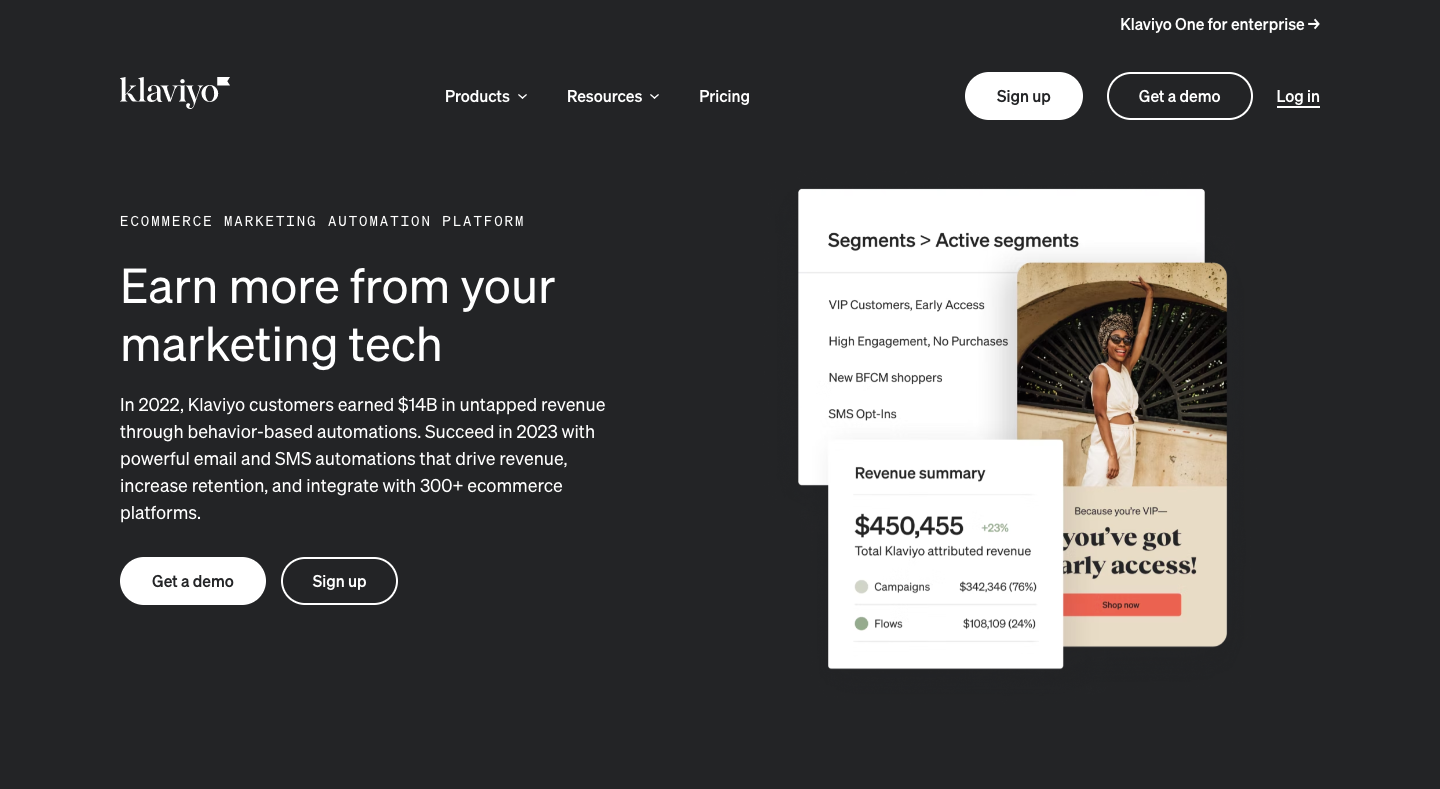 Klaviyo—just like Drip and Omnisend—is an ecommerce-focused marketing automation platform. But whereas Drip and Omnisend are do-it-yourself tools, Klaviyo really requires an in-house dev team or a full-service agency to use it effectively, making it more popular with big-budget brands. So which is right for you?
Klaviyo—just like Drip and Omnisend—is an ecommerce-focused marketing automation platform. But whereas Drip and Omnisend are do-it-yourself tools, Klaviyo really requires an in-house dev team or a full-service agency to use it effectively, making it more popular with big-budget brands. So which is right for you?
What Makes Klaviyo the Best Omnisend Alternative?
- Predictive ecommerce analytics. With Klaviyo, you can use predictive analytics to enhance your segmentation strategy, allowing you to identify (for example) when an individual customer will place their next order or how likely they are to churn. Omnisend doesn’t currently offer this.
- Advanced reporting. It’s hard to beat Klaviyo’s ecommerce reporting functionality, giving customers access to lifetime store data and pulling in information from other channels (like loyalty program software and customer reviews). Omnisend’s most advanced reporting features are only available at Pro level.
- Sophisticated A/B testing. Omnisend’s split-testing functionality is a little limited, only allowing you to test different subject line and sender name variants. By contrast, Klaviyo lets you test pretty much everything, including CTA styles, body content, and send times.
- More integrations. Klaviyo has over twice as many prebuilt app integrations as Omnisend. So while Omnisend isn’t missing anything too obvious (other than Google Analytics), Klaviyo is the clear winner here.
How Does Klaviyo Compare to Omnisend?
| Klaviyo | Omnisend | |
| Best Feature | Personalization and segmentation tools allow you to create customer segments based on real-time data. | Web push notifications allow brands to instantly retarget customers. |
| Best For | Ecommerce agencies and developers | Ecommerce marketers |
| Pros | More sophisticated analytics, reporting, and testing. | Cheaper prices across the board (without a huge trade-off in functionality). |
| Cons | Pretty expensive price plans, and requires advanced technical skills to use it properly. | A/B testing features are quite basic. |
| Pricing/Month | Free for up to 250 contacts and 500 monthly email sends; paid plans priced from $20 per month for up to 500 contacts and 5,000 monthly email sends. | Free to reach up to 250 contacts per month, including 500 monthly email sends, up to 60 SMS messages, and up to 500 web push notifications. Paid plans start at $16 per month to reach up to 500 contacts (including unlimited push notifications). |
| Support | After the extensive onboarding program, support is limited to live chat and emails. | All users get 24/7 email and live chat support, while Pro and Enterprise subscribers also get a dedicated customer success manager. |
3. Mailchimp
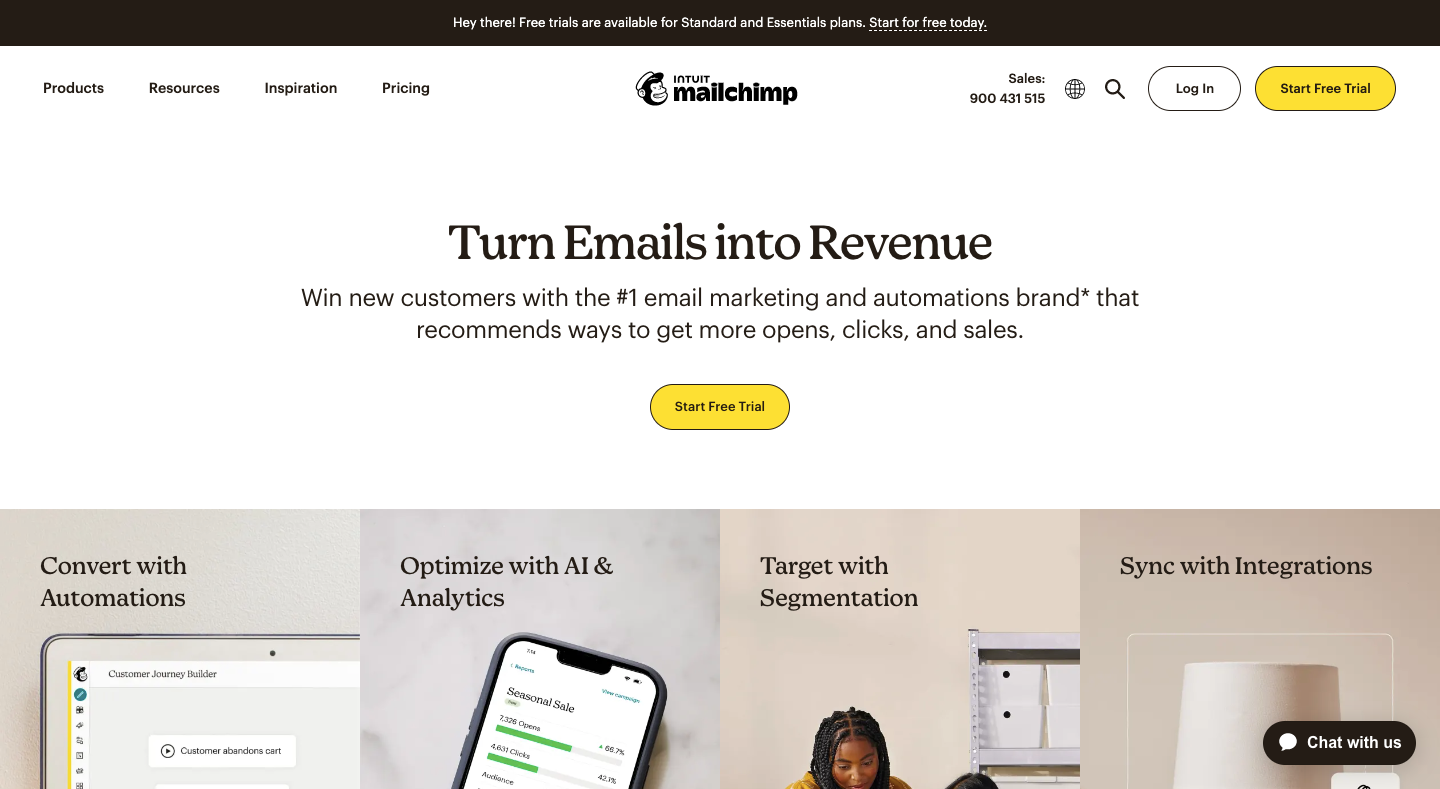 Mailchimp is certainly one of the best-known email marketing platforms. And while it’s not ecommerce-specific, it still offers plenty of ecommerce functionality. But is it a viable alternative to a dedicated tool like Omnisend?
Mailchimp is certainly one of the best-known email marketing platforms. And while it’s not ecommerce-specific, it still offers plenty of ecommerce functionality. But is it a viable alternative to a dedicated tool like Omnisend?
What Makes Mailchimp the Best Omnisend Alternative?
- Send more emails for free. Traditionally, Mailchimp offered arguably the most generous free plan of any email marketing tool. While its functionality has been watered down in recent years, it still lets you send 1,000 emails to 500 contacts without paying a cent. Omnisend’s free tier offers more all-round features, but only half as many emails.
- Enhanced email design testing. Paying Mailchimp customers get (limited) access to Inbox Preview, allowing them to see how their email designs will look across different devices and email clients. Omnisend lets you preview emails on mobile and desktop, but not on different email clients.
- More detailed reports and analytics. Both platforms offer excellent analytics packages (albeit the more sophisticated features aren’t available to lower-tier subscribers), but Mailchimp has a slight edge thanks to its built-in social media reporting and geolocation tracking.
- Integrate with more tools and apps. Mailchimp offers 300+ integrations (not that we’ve counted them), whereas Omnisend “only” has about 150.
- More landing page templates. At time of writing, Omnisend only has five landing page templates. Mailchimp has twice as many.
How Does Mailchimp Compare to Omnisend?
| Mailchimp | Omnisend | |
| Best Feature | Advanced analytics and reporting help marketers make data-driven decisions. | Web push notifications allow brands to instantly retarget customers. |
| Best For | Small businesses | Ecommerce marketers |
| Pros | Better email design testing and analytics. | Cheaper for sending higher email volumes to larger list sizes; offers more marketing channels (email + SMS + push notifications). |
| Cons | More expensive for larger list sizes; free users only get access to very basic templates. | Not a good fit if you aren’t in ecommerce. |
| Pricing/Month | Free for up to 500 contacts and 1,000 monthly email sends; paid plans start at $13 per month for 500 contacts and 5,000 monthly email sends. | Free to reach up to 250 contacts per month, including 500 monthly email sends, up to 60 SMS messages, and up to 500 web push notifications. Paid plans start at $16 per month to reach up to 500 contacts (including unlimited push notifications). |
| Support | Paid plans include 24/7 support via chat and email. Phone and priority support is only available to Premium customers paying $350+ per month. | All users get 24/7 email and live chat support, while Pro and Enterprise subscribers also get a dedicated customer success manager. |
4. GetResponse
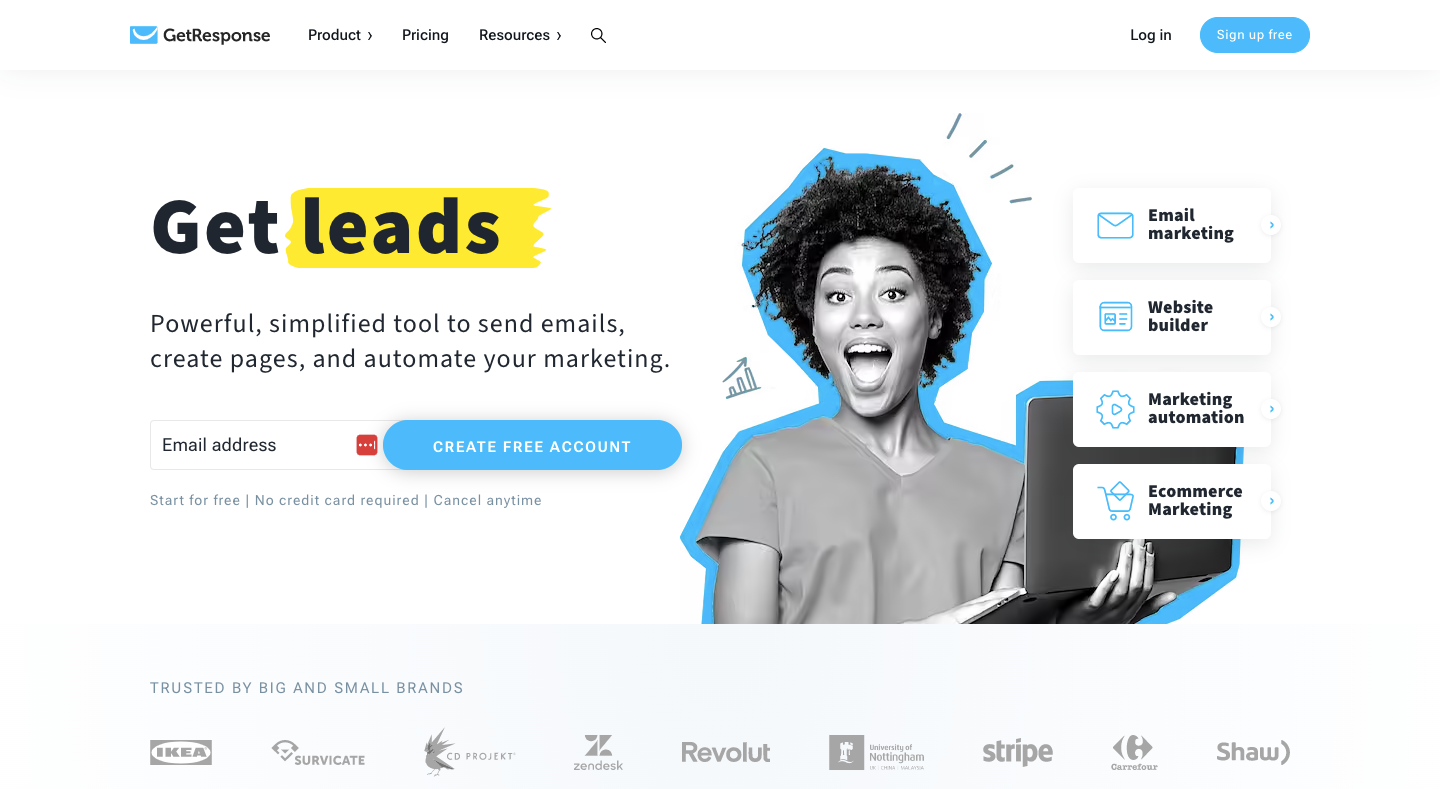 GetResponse is another all-rounder. In fact, it claims to serve everyone from solopreneurs to large companies, with an impressive client list including the likes of Ikea, Red Bull, and Zendesk. Of course, none of those are ecommerce brands. So how does GetResponse rate as an Omnisend alternative?
GetResponse is another all-rounder. In fact, it claims to serve everyone from solopreneurs to large companies, with an impressive client list including the likes of Ikea, Red Bull, and Zendesk. Of course, none of those are ecommerce brands. So how does GetResponse rate as an Omnisend alternative?
What Makes GetResponse the Best Omnisend Alternative?
- Feature-packed free plan. While any free functionality is better than none, GetResponse’s free plan is a little more generous: you get 500 contacts and 2,500 monthly email sends, while Omnisend only offers up to 500 emails per month to up to 250 contacts.
- Cheaper email marketing. Although GetResponse doesn’t exactly position itself as a cheap platform, it’s certainly more affordable than Omnisend if you’re predominantly looking to send emails. For $19/month, GetResponse gives you unlimited emails and up to 1,000 contacts; Omnisend charges $20/month for the same list size but only 12,000 monthly emails.
- Built-in website creation. GetResponse’s AI-powered website builder is available to all customers, even those on the free plan. Omnisend doesn’t have a website builder, although it does offer a limited range of landing page templates.
- Inclusive webinar hosting. If webinars are a key part of your marketing plan, GetResponse could be the perfect choice, because it offers built-in webinar hosting at Marketing Automation level and above. Omnisend doesn’t offer this.
- AI email generator. GetResponse’s GPT-3.5 email generator is capable of building emails in seconds based on a few simple prompts, like your goal, tone of voice, and design preferences. Again, Omnisend doesn’t currently do anything comparable.
How Does GetResponse Compare to Omnisend?
| GetResponse | Omnisend | |
| Best Feature | Built-in GPT-3.5-powered email generator. | Web push notifications allow brands to instantly retarget customers. |
| Best For | Small businesses that need advanced marketing tools | Ecommerce marketers |
| Pros | Generally cheaper prices (provided all you want is the ability to send emails); a better fit for non-ecommerce businesses; more generous free plan. | Advanced functionality (like automations and SMS marketing) available to all users; offers more marketing channels. |
| Cons | Charges more for marketing automation. | If you’re not in ecommerce, you’re better off with a more generalist tool. |
| Pricing/Month | Free for up to 500 contacts and 2,500 monthly email sends. Paid plans start at $13.30 per month for 1,000 contacts and unlimited email sends. | Free to reach up to 250 contacts per month, including 500 monthly email sends, up to 60 SMS messages, and up to 500 web push notifications. Paid plans start at $16 per month to reach up to 500 contacts (including unlimited push notifications). |
| Support | Paid plans include 24/7 support via chat and email. Phone support is only available at top-tier MAX2 level; some MAX2 customers can also access Slack support. | All users get 24/7 email and live chat support, while Pro and Enterprise subscribers also get a dedicated customer success manager. |
5. Brevo (FKA Sendinblue)
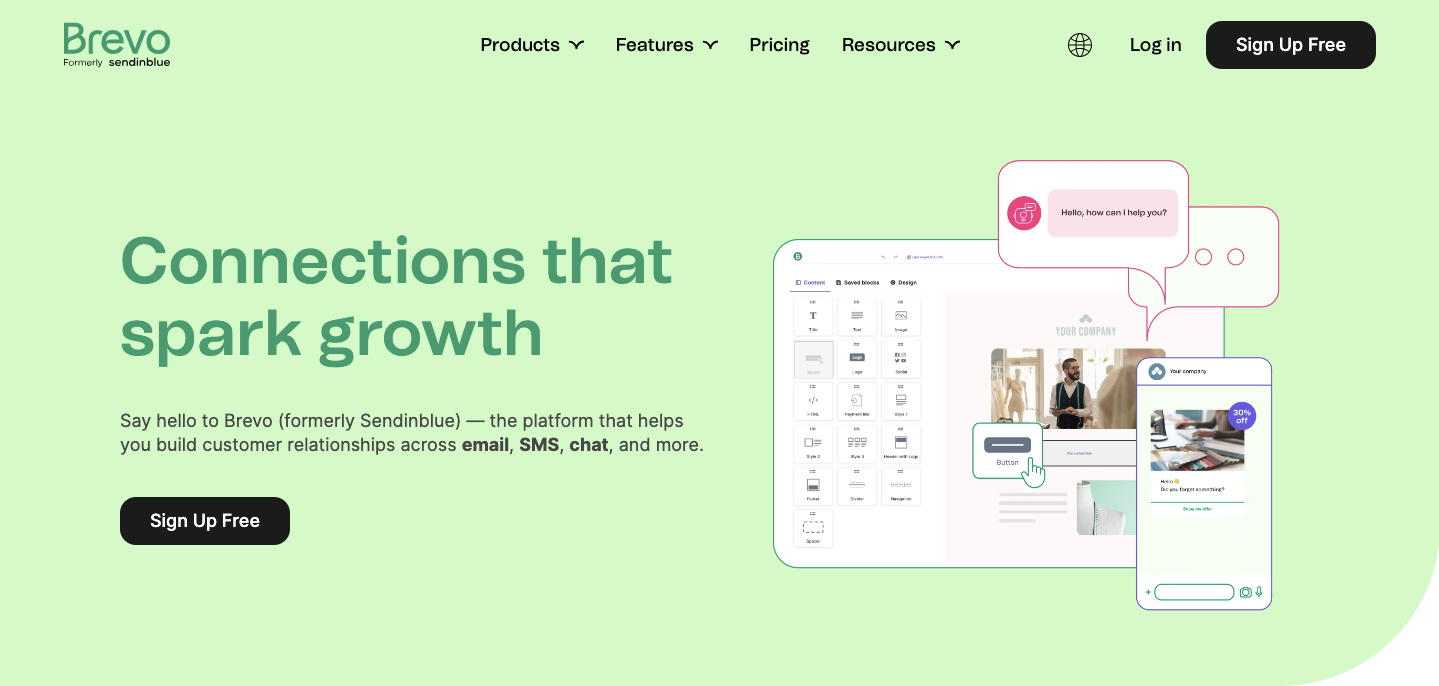 Brevo is an email marketing platform that you might know by its former name, Sendinblue. With its low-cost plans and generous feature set, it’s grown a substantial customer base of 500,000+ businesses across 180 countries. Should you join them?
Brevo is an email marketing platform that you might know by its former name, Sendinblue. With its low-cost plans and generous feature set, it’s grown a substantial customer base of 500,000+ businesses across 180 countries. Should you join them?
What Makes Brevo the Best Omnisend Alternative?
- Superb free plan. Brevo’s plan is probably the best on the market, allowing you to send up to 300 emails a day to unlimited contacts. Importantly, this includes transactional emails—a key feature for ecommerce brands. Omnisend’s free plan is nowhere near as generous.
- Cheaper for large list sizes. All Brevo plans offer unlimited contacts (that’s right, even the free one), so it’s a great fit for brands with large email lists.
- Low-cost pay-as-you-go SMS marketing. Want to run the occasional SMS campaign? Brevo’s pay-as-you-go prices are cheaper than Omnisend’s (e.g. sending 10,000 SMS messages in the US costs $109 with Brevo and $150 with Omnisend).
- Direct WordPress integration. If WordPress is your CMS of choice, you’ll be delighted to learn that Brevo offers a dedicated email plugin for the platform. Omnisend doesn’t.
How Does Brevo Compare to Omnisend?
| Brevo | Omnisend | |
| Best Feature | Send transactional emails with guaranteed 97 percent deliverability. | Web push notifications allow brands to instantly retarget customers. |
| Best For | Low-budget email marketing | Ecommerce marketers |
| Pros | More generous free plan and cheaper prices, especially for businesses with large marketing lists. | Offers more advanced ecommerce features as standard. |
| Cons | Less sophisticated ecommerce functionality (e.g. it lacks a built-in product picker). | Generally more expensive for email and SMS campaigns. |
| Pricing/Month | Free for unlimited contacts and up to 300 emails per day. Paid plans start at $25 per month for unlimited contacts and 20,000 emails per month. | Free to reach up to 250 contacts per month, including 500 monthly email sends, up to 60 SMS messages, and up to 500 web push notifications. Paid plans start at $16 per month to reach up to 500 contacts (including unlimited push notifications). |
| Support | The $25+ per month Starter plan only offers email-based support. To receive personalized support, you’ll need to subscribe to an Enterprise plan. | All users get 24/7 email and live chat support, while Pro and Enterprise subscribers also get a dedicated customer success manager. |
6. ConvertKit
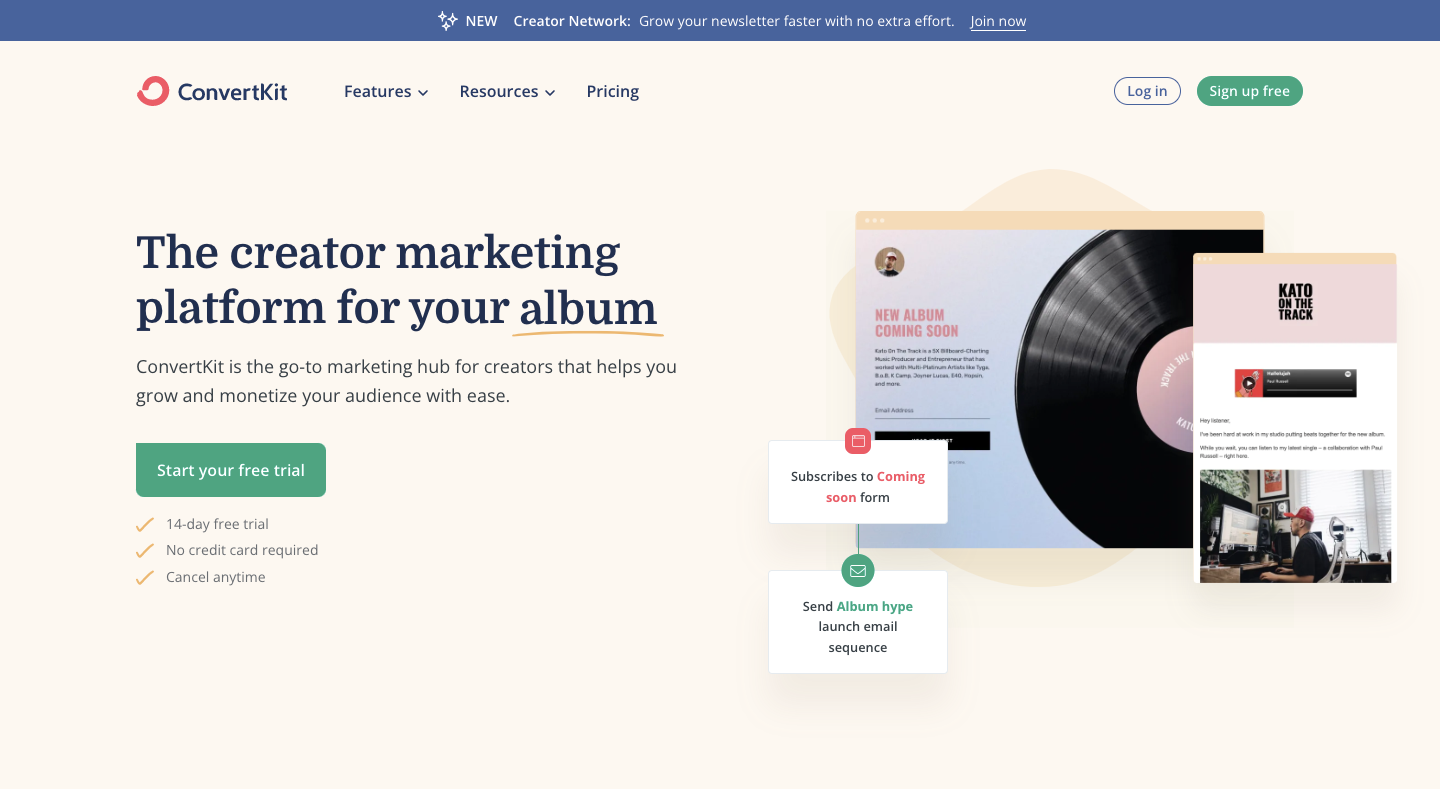 Comparing ConvertKit to Omnisend is kind of a weird one, because they serve totally different audiences: Omnisend is for ecommerce brands and ConvertKit is for content creators. Still, if you do a bit of both, you might be torn on which platform is the right fit. Let’s see if we can help…
Comparing ConvertKit to Omnisend is kind of a weird one, because they serve totally different audiences: Omnisend is for ecommerce brands and ConvertKit is for content creators. Still, if you do a bit of both, you might be torn on which platform is the right fit. Let’s see if we can help…
What Makes ConvertKit the Best Omnisend Alternative?
- Attractive free plan. Like Brevo, ConvertKit has a superb free plan, giving you unlimited emails, forms, and landing pages and up to 1,000 contacts. It blows Omnisend’s free plan out the park.
- In-platform creator network. ConvertKit’s Creator Network allows customers to recommend (and be recommended by) other creators, providing a simple-yet-effective way to grow your audience. Unsurprisingly, Omnisend—which isn’t built for content creators—doesn’t offer anything similar.
- Newsletter monetization. Got at least 10,000 newsletter subscribers? ConvertKit will help you land paid sponsorship deals, giving you an additional way to monetize your content. Again, you won’t get that from Omnisend.
- Inclusive referral marketing. ConvertKit Creator Pro subscribers get inclusive access to SparkLoop’s referral marketing platform, giving them another way to expand their reach. Omnisend integrates with a couple referral marketing tools—but you’ll have to pay extra for them.
How Does ConvertKit Compare to Omnisend?
| ConvertKit | Omnisend | |
| Best Feature | Integrated newsletter referral program helps creators grow their reach by leveraging their existing audience. | Web push notifications allow brands to instantly retarget customers. |
| Best For | Content creators | Ecommerce marketers |
| Pros | Built-in newsletter monetization and audience growth tools. | Far more sophisticated ecommerce automations, segmentation, and templates. |
| Cons | Only offers limited ecommerce functionality. | No content creator-specific features (like built-in referral marketing). |
| Pricing/Month | Free for up to 1,000 subscribers and unlimited email sends; paid plans start at $9 per month for up to 300 subscribers and unlimited sends. | Free to reach up to 250 contacts per month, including 500 monthly email sends, up to 60 SMS messages, and up to 500 web push notifications. Paid plans start at $16 per month to reach up to 500 contacts (including unlimited push notifications). |
| Support | Paying customers get live chat and email support, with priority access offered to Creator Pro subscribers. Free subscribers only get community support. | All users get 24/7 email and live chat support, while Pro and Enterprise subscribers also get a dedicated customer success manager. |
7. ActiveCampaign
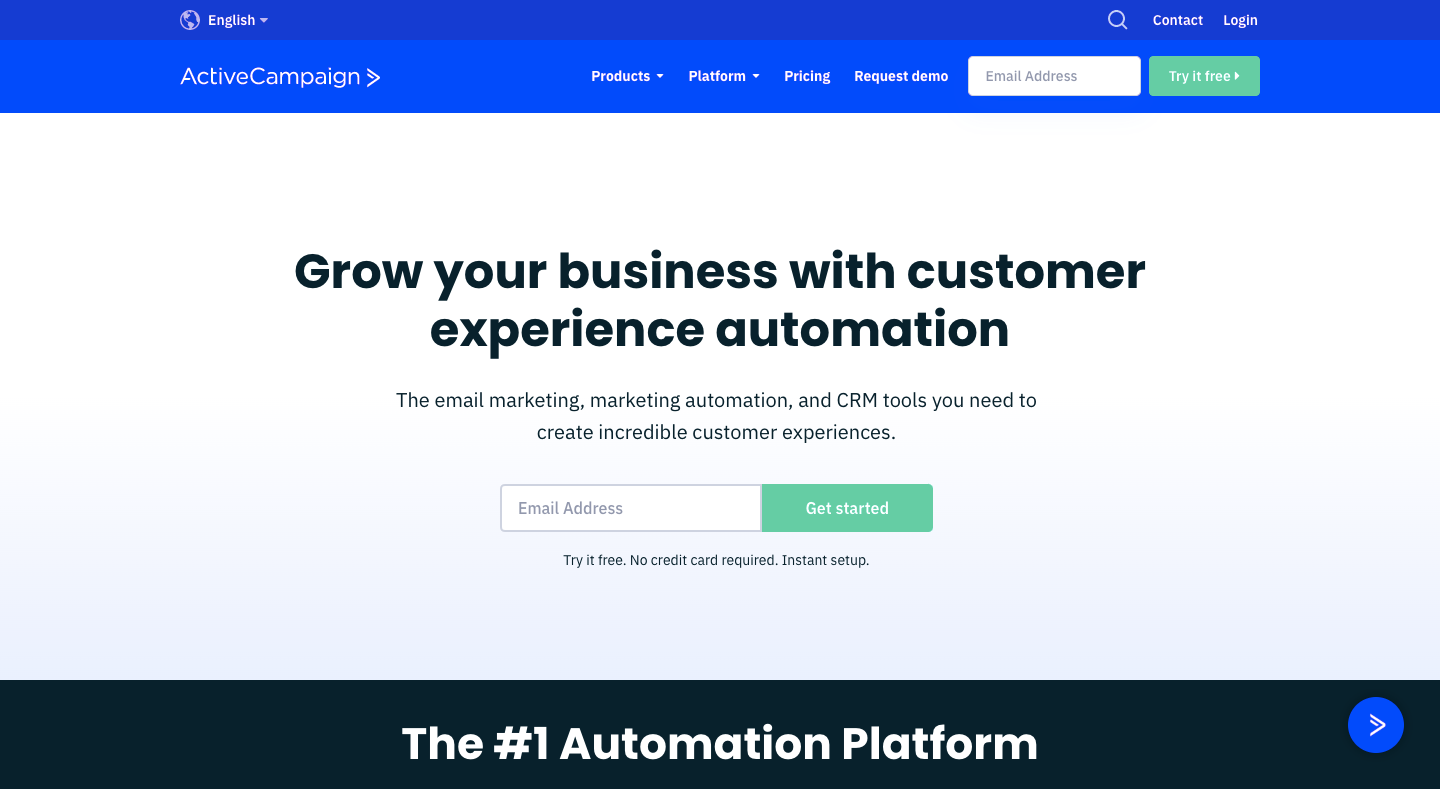 ActiveCampaign is one of the most advanced marketing automation platforms—and while it’s essentially an all-rounder, it’s packed with ecommerce-friendly tools and features. But can it truly compete with an ecommerce-specific platform like Omnisend?
ActiveCampaign is one of the most advanced marketing automation platforms—and while it’s essentially an all-rounder, it’s packed with ecommerce-friendly tools and features. But can it truly compete with an ecommerce-specific platform like Omnisend?
What Makes ActiveCampaign the Best Omnisend Alternative?
- Machine learning-driven predictive actions. ActiveCampaign uses machine learning to optimize campaign performance through predictive actions, such as sending emails when subscribers are most likely to open them. Omnisend doesn’t currently offer this.
- More email templates. Both Omnisend and ActiveCampaign offer professional-quality email templates—it’s just that ActiveCampaign has far more of them. At time of writing, its library contains 150+ email templates, whereas Omnisend has fewer than 40.
- More native integrations. ActiveCampaign integrates with over 870 tools and apps, while Omnisend has about 150 native integrations. Both integrate with pretty much everything you’ll ever need, but ActiveCampaign is the clear winner here.
- Unlimited inactive contacts. Every marketing list contains some inactive subscribers. Whereas most platforms include them in your contact limit, ActiveCampaign gives you unlimited inactive contacts on all plans, so there’s less chance you’ll be inadvertently bumped up to a higher tier as your list grows.
How Does ActiveCampaign Compare to Omnisend?
| ActiveCampaign | Omnisend | |
| Best Feature | Predictive actions use machine learning to deliver customer experiences based on data, such as the best time to send emails. | Web push notifications allow brands to instantly retarget customers. |
| Best For | Advanced marketers who need high-level automation | Ecommerce marketers |
| Pros | Inactive contacts don’t count toward your list size; advanced predictive actions. | Has a free plan; cheaper prices across the board; includes push notification campaigns. |
| Cons | More expensive plans. | No predictive actions to optimize your campaigns. |
| Pricing/Month | From $29 per month for one user and unlimited emails. | Free to reach up to 250 contacts per month, including 500 monthly email sends, up to 60 SMS messages, and up to 500 web push notifications. Paid plans start at $16 per month to reach up to 500 contacts (including unlimited push notifications). |
| Support | All ActiveCampaign plans offer 24/7 email and chat-based support, but only Enterprise customers get over-the-phone support. | All users get 24/7 email and live chat support, while Pro and Enterprise subscribers also get a dedicated customer success manager. |
8. AWeber
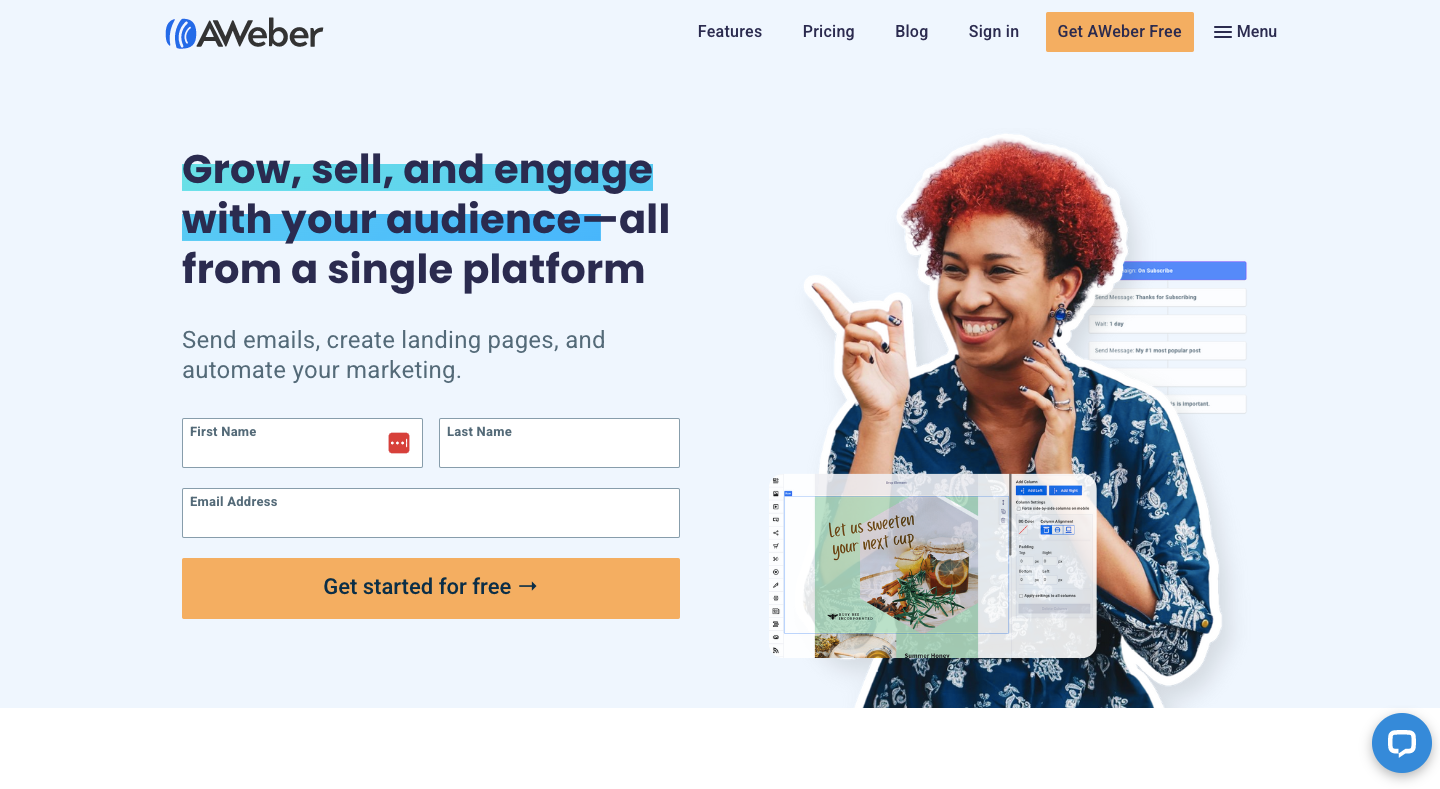 AWeber is an affordable and user-friendly email platform that’s been around since way before “marketing automation” was a thing. However, it’s added a bunch of more advanced functionality in recent years to help it keep pace with the competition. So how does it compare to Omnisend today?
AWeber is an affordable and user-friendly email platform that’s been around since way before “marketing automation” was a thing. However, it’s added a bunch of more advanced functionality in recent years to help it keep pace with the competition. So how does it compare to Omnisend today?
What Makes AWeber the Best Omnisend Alternative?
- Send more emails for free. AWeber’s free plan includes 3,000 monthly email sends to up to 500 contacts—that’s six times more emails than you get with Omnisend’s free plan.
- Cheaper for high email volumes. First and foremost, AWeber is an email tool. This is reflected in its paid plans, all of which offer unlimited emails. For instance, you can send as many emails as you like to 2,500 subscribers for $22.50/month. Omnisend’s most similar package charges $35/month for up to 2,500 subscribers and “just” 30,000 monthly emails.
- More integrations. Omnisend offers ~150 integrations, compared to 750+ from AWeber. And it’s also missing a Google Analytics integration, which could be a dealbreaker for some customers.
- Phone-based support. All AWeber customers—even those on the free plan—can pick up the phone and speak to a support agent. Omnisend doesn’t offer any over-the-phone support (although you access a customer success manager for $400+).
How Does AWeber Compare to Omnisend?
| AWeber | Omnisend | |
| Best Feature | Create email templates in seconds using your website or Facebook page URL. | Web push notifications allow brands to instantly retarget customers. |
| Best For | Startups and small businesses | Ecommerce marketers |
| Pros | Cheaper prices if you’re just looking to send high email volumes; more generous free plan. | Offers SMS marketing as well as email and push notifications; revenue-focused reporting. |
| Cons | Supports fewer marketing channels; less detailed reporting. | Generally more expensive (but with more functionality). |
| Pricing/Month | Free for up to 500 email subscribers and 3,000 monthly email sends; paid plans priced from $12.50 per month for up to 500 subscribers and unlimited emails. | Free to reach up to 250 contacts per month, including 500 monthly email sends, up to 60 SMS messages, and up to 500 web push notifications. Paid plans start at $16 per month to reach up to 500 contacts (including unlimited push notifications). |
| Support | All users—even free subscribers—can access 24/7 live support via phone, email, and chat (although paying customers are placed in a priority queue). | All users get 24/7 email and live chat support, while Pro and Enterprise subscribers also get a dedicated customer success manager. |
9. Constant Contact
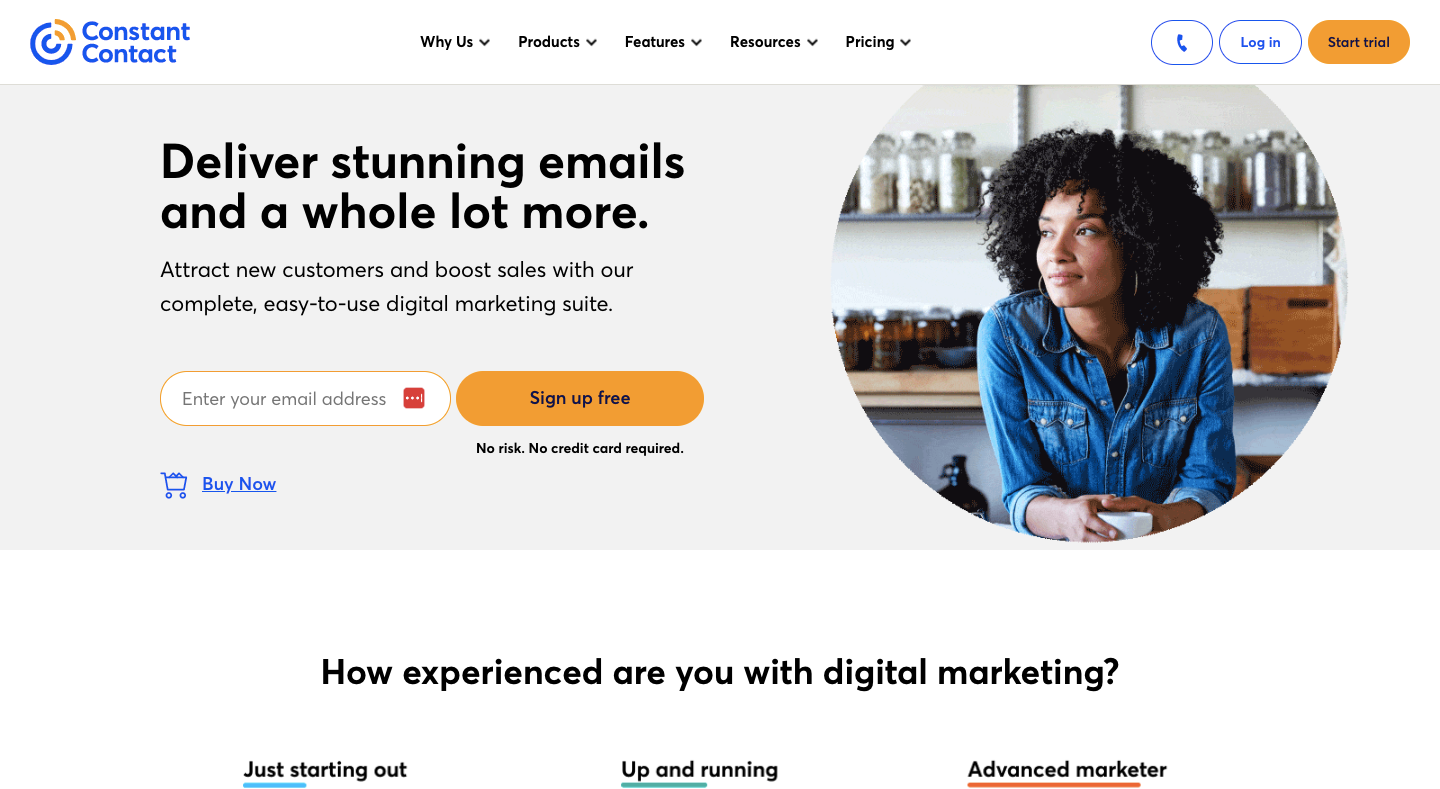 Constant Contact is similar to AWeber: they’re both old-school email marketing platforms that have bolstered their feature sets with lots of jazzy new tools. But is Contact Contact a decent Omnisend alternative?
Constant Contact is similar to AWeber: they’re both old-school email marketing platforms that have bolstered their feature sets with lots of jazzy new tools. But is Contact Contact a decent Omnisend alternative?
What Makes Constant Contact the Best Omnisend Alternative?
- Built-in social scheduling. One of Constant Contact’s biggest differentiators is its ability to schedule organic social posts and manage ad campaigns within the platform. Omnisend doesn’t have any built-in social media functionality.
- “Free” event marketing tools. Constant Contact customers can access event marketing tools that allow them to create registration forms, send invites via email, sell tickets, and more. Omnisend doesn’t do most of that stuff—and it doesn’t currently integrate directly with any event marketing software.
- Phone-based customer support. Like AWeber, Constant Contact offers phone-based support on all price plans, whereas Omnisend only offers support via live chat and email.
How Does Constant Contact Compare to Omnisend?
| Constant Contact | Omnisend | |
| Best Feature | Manage campaigns on the go from a dedicated mobile app. | Web push notifications allow brands to instantly retarget customers. |
| Best For | Nonprofits and charities (they save up to 30 percent on standard Constant Contact prices) | Ecommerce marketers |
| Pros | Built-in social media and event management tools. | Far more sophisticated reporting and automations; cheaper pricing. |
| Cons | Expensive prices for a comparatively limited feature set; no free plan. | No social media scheduling within the platform. |
| Pricing/Month | From $12 per month for up to 500 contacts and 5,000 monthly email sends. | Free to reach up to 250 contacts per month, including 500 monthly email sends, up to 60 SMS messages, and up to 500 web push notifications. Paid plans start at $16 per month to reach up to 500 contacts (including unlimited push notifications). |
| Support | All plans offer live chat and phone support, while Standard and Premium customers get onboarding calls too. | All users get 24/7 email and live chat support, while Pro and Enterprise subscribers also get a dedicated customer success manager. |
10. HubSpot
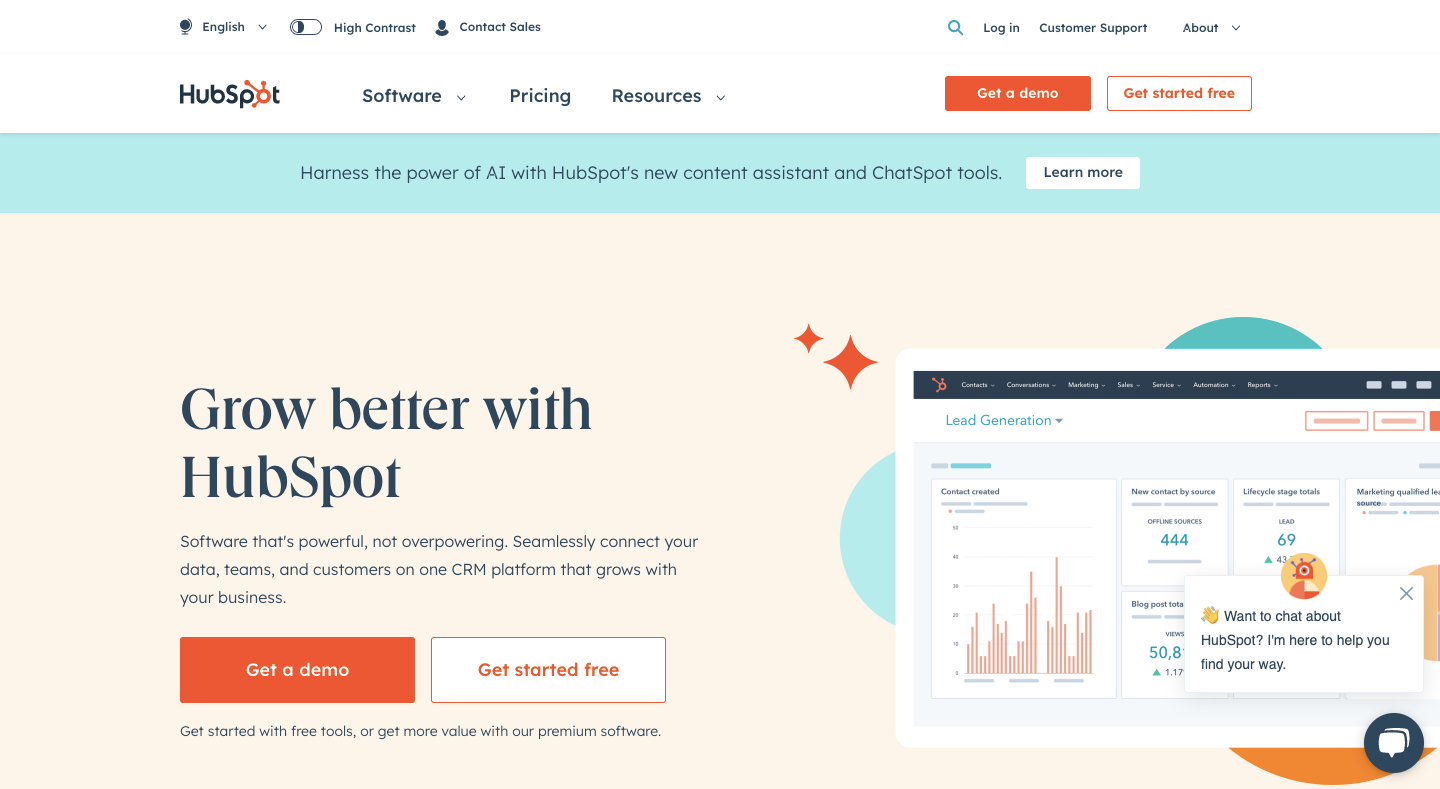 HubSpot is certainly the most feature-rich of all the Omnisend alternatives in our roundup, with a suite of tools that go way beyond email marketing. It’s most commonly used by B2B brands, so how does it stack up against Omnisend, which is predominantly for B2C ecommerce?
HubSpot is certainly the most feature-rich of all the Omnisend alternatives in our roundup, with a suite of tools that go way beyond email marketing. It’s most commonly used by B2B brands, so how does it stack up against Omnisend, which is predominantly for B2C ecommerce?
What Makes HubSpot the Best Omnisend Alternative?
- Bring together multiple business functions. HubSpot offers marketing, sales, customer support, operations, and content management functionality within a single platform, whereas Omnisend is just a marketing tool.
- Diverse free plan. HubSpot definitely isn’t the cheapest option, but it does offer a handy free plan that includes unlimited contacts, 2,000 monthly email sends, and even limited segmentation and automation features. Omnisend’s free tier is far more stingy.
- Superb (free) CRM. While Omnisend functions as an ecommerce CRM, it can’t really compete with HubSpot’s customer relationship management tool, which is one of the best on the market—and it’s totally free.
- (Way) more integrations. HubSpot offers 1,000+ integrations—far more than you’ll ever need. That’s almost 10 times more than Omnisend (although, to be clear, most users will be perfectly happy with Omnisend’s integrations, too).
How Does HubSpot Compare to Omnisend?
| HubSpot | Omnisend | |
| Best Feature | Connect marketing, sales, content management, and customer service in a single platform. | Web push notifications allow brands to instantly retarget customers. |
| Best For | B2B inbound marketing | Ecommerce marketers |
| Pros | Generous free tools; combines multiple functions in a single platform. | Cheaper prices; more affordable access to advanced ecommerce functionality. |
| Cons | Pretty expensive, especially if you’re “just” looking for a marketing automation tool. | If you’re not an ecommerce brand, Omnisend’s not for you. |
| Pricing/Month | Free marketing plan includes unlimited contacts and 2,000 monthly email sends. Paid marketing plans start at $18 per month for 1,000 contacts and 5,000 monthly sends. | Free to reach up to 250 contacts per month, including 500 monthly email sends, up to 60 SMS messages, and up to 500 web push notifications. Paid plans start at $16 per month to reach up to 500 contacts (including unlimited push notifications). |
| Support | Paying customers can get 1:1 email and in-app chat support. Phone support is available at Pro level and above. | All users get 24/7 email and live chat support, while Pro and Enterprise subscribers also get a dedicated customer success manager. |
Frequently Asked Questions
There sure are! Omnisend is an excellent tool, but there might be better choices for your brand. Ecommerce marketers might favor Drip’s user-friendly interface and affordable access to advanced reporting and segmentation, whereas anyone from outside the ecommerce world will be better served by one of the many all-round automation platforms (like Brevo, GetResponse, and Mailchimp).
Google doesn’t offer a true alternative to Omnisend. However, you can turn Gmail into a (very) basic email marketing tool using a third-party plugin.
Omnisend is definitely one of the best email tools. But whether it’s the best choice for your brand depends on your business type and marketing goals.
In our view, Omnisend’s biggest weakness is the lack of functionality outside of its top-tier Pro plan. If you want advanced ecommerce reporting and unlimited email sends, you’ll need to pay at least $59/month—and the costs ramp up fast based on the size of your marketing list. It also has fewer integrations than most of its competitors, and doesn’t integrate with Google Analytics, which could pose a problem for some users.

Conclusion
Make no bones about it: Omnisend is a high-quality ecommerce marketing automation platform.
However, we’re confident Drip is a better fit for most ecommerce brands.
All Drip customers get access to our full suite of sophisticated automations, segmentation tools, and reporting features. And we’re always on hand to provide customized advice and recommendations when you need us.
But we’re not going to convince you with words alone, so see for yourself by signing up for your 14-day free trial today!
